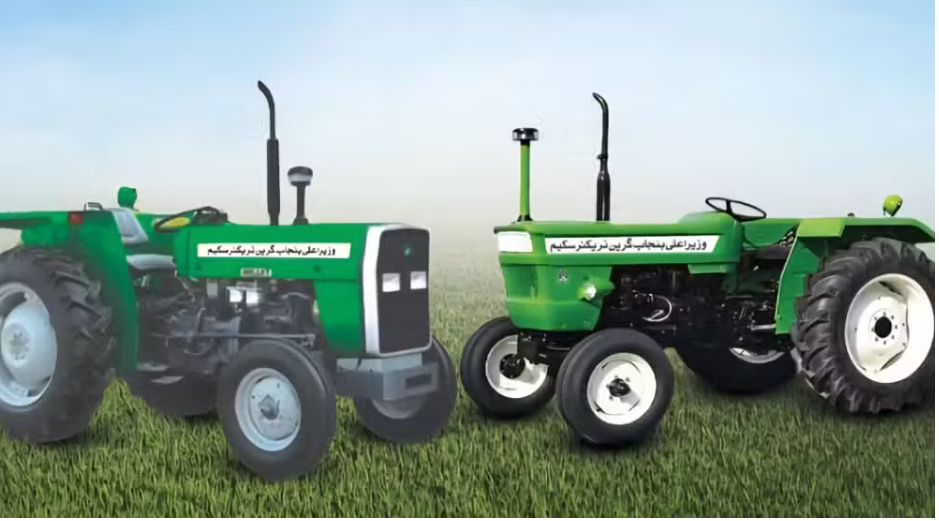Introduction
Building on the success of Phase 1, the Punjab government has now launched Phase 2 of the Green Tractor Scheme, aiming to empower more small- and medium-scale farmers with modern farming machinery at subsidized rates. With enhanced coverage, added perks, and transparent execution, this initiative promises to transform agricultural productivity across the province.
1. 🛠️ What’s in Phase 2?
- Total Allocation: 20,000 tractors—split equally between mid‑range (50–65 HP) and high‑power (75 HP+) units, including both locally manufactured and imported models.
- Subsidy Structure:
- Rs 500,000 for 50–65 HP tractors (locally made)
- Rs 1 million for 75 HP+ tractors (local & imported)
- Budget Details: Approximately Rs 5–5.5 billion allocated specifically for Phase 2.
2. ✅ Goals & Highlights
- Accessibility & Equity
A transparent balloting system ensures fair distribution, with active encouragement for female farmers to participate. - Localized Support Infrastructure
Nearly all four Model Agriculture Malls are 98% completed, with 10 more planned—serving as hubs for equipment and advisory services. - Capacity Building
The Agriculture Graduates Internship Program Phase 2 will enroll 2,000 fresh graduates, aimed at fostering skilled manpower in the Here’s a polished blog post draft on Phase 2 of the Green Tractor Scheme in Punjab:
🌱 Phase 2 of the Green Tractor Scheme – A New Dawn for Punjab Farmers
Introduction
Building on the success of Phase 1, the Punjab government has now launched Phase 2 of the Green Tractor Scheme, aiming to empower more small- and medium-scale farmers with modern farming machinery at subsidized rates. With enhanced coverage, added perks, and transparent execution, this initiative promises to transform agricultural productivity across the province.
1. 🛠️ What’s in Phase 2?
Total Allocation: 20,000 tractors—split equally between mid‑range (50–65 HP) and high‑power (75 HP+) units, including both locally manufactured and imported models.
Subsidy Structure:
Rs 500,000 for 50–65 HP tractors (locally made)
Rs 1 million for 75 HP+ tractors (local & imported)
Budget Details: Approximately Rs 5–5.5 billion allocated specifically for Phase 2.
2. ✅ Goals & Highlights
Accessibility & Equity
A transparent balloting system ensures fair distribution, with active encouragement for female farmers to participate.
Localized Support Infrastructure
Nearly all four Model Agriculture Malls are 98% completed, with 10 more planned—serving as hubs for equipment and advisory services.
Capacity Building
The Agriculture Graduates Internship Program Phase 2 will enroll 2,000 fresh graduates, aimed at fostering skilled manpower in the agricultural sector.
3. 📅 Key Dates & Application Process
Date
Activity
August 2025
Launch of online/offline applications
July–Aug 2025
Application period
Mid‑August 2025
Balloting of successful applicants
September 2025 onward
Tractor delivery begins
How to Apply:
Online: Via the official portal (gts.punjab.gov.pk), starting August.
Offline: Submit physical forms at district agriculture offices.
Required documents include CNIC, landholding proof (1–50 acres), bank details, and any previous tractor subsidy certificates.
4. 🌾 Why It Matters
Modernizing Farming: Access to modern, fuel-efficient tractors accelerates sowing, plowing, and harvesting—reducing labor costs and boosting yields.
Youth & Women Empowerment: Including graduates and encouraging female applicants promotes a more inclusive and progressive farming ecosystem.
Rural Infrastructure: Complete malls and curriculum-driven internships lay the groundwork for sustainable agricultural growth.
5. 👨🌾 Farmer Success Stories
Last year’s scheme impact was visible:
“In the first phase of the Green Tractors Programme, 9,500 lucky farmers have already received tractors, and in the second phase, an additional 20,000 tractors will be distributed.”
During a recent “Grow More Wheat” campaign in Multan, 1,000 tractors were distributed via balloting, with top-performing farmers awarded 85 HP tractors and substantial financial incentives.
6. 📝 Final Thoughts
Phase 2 of the Green Tractor Scheme is a decisive stride toward agricultural modernization in Punjab. With ample subsidies, clear processes, and a focus on inclusion, it promises to uplift farmers and bolster Pakistan’s food security.
What farmers should do now:
Stay alert for announcements in early August 2025.
Gather and verify all required documents.
Apply promptly—every application counts.
Let me know if you’d like a printable guide, step-by-step visuals, or a Q&A post for farmers!
3. 📅 Key Dates & Application Process
| Date | Activity |
|---|---|
| August 2025 | Launch of online/offline applications |
| July–Aug 2025 | Application period |
| Mid‑August 2025 | Balloting of successful applicants |
| September 2025 onward | Tractor delivery begins |
How to Apply:
- Online: Via the official portal (gts.punjab.gov.pk), starting August.
- Offline: Submit physical forms at district agriculture offices.
Required documents include CNIC, landholding proof (1–50 acres), bank details, and any previous tractor subsidy certificates.
4. 🌾 Why It Matters
- Modernizing Farming: Access to modern, fuel-efficient tractors accelerates sowing, plowing, and harvesting—reducing labor costs and boosting yields.
- Youth & Women Empowerment: Including graduates and encouraging female applicants promotes a more inclusive and progressive farming ecosystem.
- Rural Infrastructure: Complete malls and curriculum-driven internships lay the groundwork for sustainable agricultural growth.
5. 👨🌾 Farmer Success Stories
Last year’s scheme impact was visible:
“In the first phase of the Green Tractors Programme, 9,500 lucky farmers have already received tractors, and in the second phase, an additional 20,000 tractors will be distributed.”
During a recent “Grow More Wheat” campaign in Multan, 1,000 tractors were distributed via balloting, with top-performing farmers awarded 85 HP tractors and substantial financial incentives.
6. 📝 Final Thoughts
Phase 2 of the Green Tractor Scheme is a decisive stride toward agricultural modernization in Punjab. With ample subsidies, clear processes, and a focus on inclusion, it promises to uplift farmers and bolster Pakistan’s food security.



